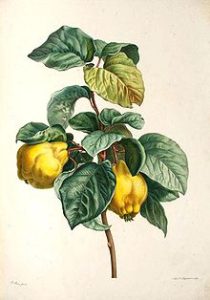Q is for…Quite a Few Things
Well, not much choice for today's instalment of the Food Alphabetical. The Larousse Gastronomique devotes only six pages to the Qs, and two of these are on quail. A lovely bird, if a bit tricky to cook well. Perhaps for another day. Let's consider some alternatives.
Q is for...Quorn
Not in this blog it's not. And when we get to T, don't bother guessing Tofu. It won't be that either.
 Q is for ... Quinoa
Q is for ... Quinoa
I confess I've never cooked with it, but where you read the word superfood (two words surely? - Ed) you are likely to find it. If, like me, you detest such nomenclature, don't pass it by for that reason alone. Quinoa (pronounced keen-wah) can in fact claim some justification for the title. It contains all eight of the amino acids. It's packed with fibre, phosphorus, iron and magnesium. And it's gluten free. And it's easy to digest.
It's a flowering plant originally from the Andes. While it's related to spinach, what you eat are the seeds. Those who know about these things describe it as a pseudo cereal. While it was originally used as animal feed, they've been eating it in Peru and Bolivia for three or four thousand years. The plant itself is apparently fairly relaxed about its growing conditions. With its ever increasing popularity (and a tripling of its price in the first decade of this century), it's now popping up all over. Cultivation in the US began in Colorado in 1983.
Onwards and upwards. I must cook with it some day.
Q is for ... Quince
 While quinoa is relatively new to us in the east, we've had quinces forever, though I do wonder who first ate one and decided it was a good idea. When raw, the skin is unpleasantly tough, and the flesh is hard and tart. It comes originally from the Caspian Sea, but can grow in a variety of habitats. We have a quince bush in our garden which gives us a significantly better crop than our idle apple tree.
While quinoa is relatively new to us in the east, we've had quinces forever, though I do wonder who first ate one and decided it was a good idea. When raw, the skin is unpleasantly tough, and the flesh is hard and tart. It comes originally from the Caspian Sea, but can grow in a variety of habitats. We have a quince bush in our garden which gives us a significantly better crop than our idle apple tree.
In ancient times the quince was known as a golden apple. When you read the legends involving Aphrodite and golden apples you can be fairly sure that quinces were involved.
Once you start cooking the fruit, it becomes a different animal. You can simply bake them, as you would an apple, but with more sugar. They figure in tagine recipes. But most commonly they are made into marmalades, jellies and pastes. Quince jelly is an excellent accompaniment to game.
As an aside, we Scots would have you believe that the word marmalade comes from a confection made for a sickly Mary, Queen of Scots (Marie est malade). A more likely explanation is that it derives from the Portuguese word marmelo, meaning quince.
We have the Iberian peninsula to thank for what is often known here as quince cheese. This is a jelly/paste. The Spanish call it membrillo and it goes divinely with manchego cheese.
Q is also for-
The quite interesting things you find in the columns of Tom's Food! Well, sometimes.
I know someone who makes a splendid Christmas Quince and Apple jam. We have 1 jar left. An autumn made batch rarely lasts until 25th December. Delicious.